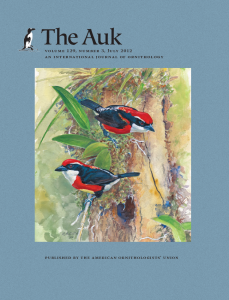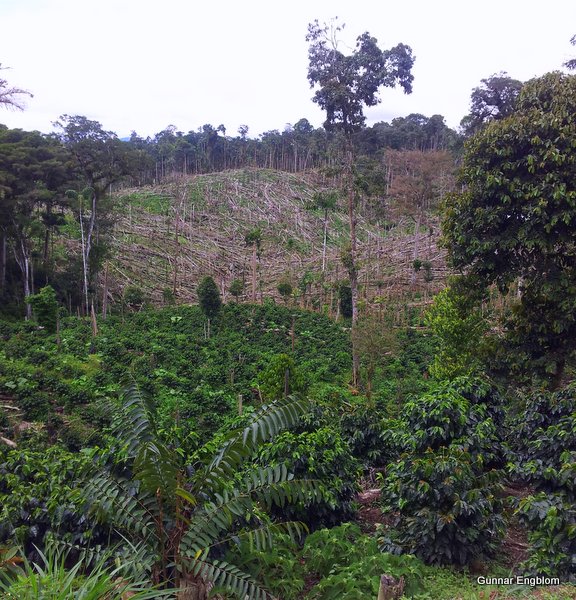How to see the Sira Barbet
New Species – Sira Barbet Capito fitzpatricki.
The July online version of The Auk has a stunning painting of the Sira Barbet Capito fitzpatricki (sp nov) descriped in this issue on its cover. It was perhaps overshadowed by the publication in the same issue the update of the AOU list. But to me the great news was the description of the new Barbet, especially since I was in the area looking for it and other birds in April. The press-release from Cornell will soon be out. And the print version of The Auk is on its way the subscribers. Meanwhile, here is the description of Sira Barbet by Glenn F. Seeholzer, Benjamin M. Winger, Michael G. Harvey, Daniel Cáceres A., 5 and Jason D. WeckStein.Identification.
The authors state that Sira Barbet is clearly a phylogenetic species, with the red flanks, broader breast band and larger bill. And there are genetic differences, albeit quite small (1.4%). It is not possible to determine whether there are ecological or genetical barriers – other than the geographic barrier, that could conclude reproducvtive isolation.
Whether South American Checklist Committee (SACC) will consider it as a species remains to be seen. Nevertheless, it is a spectacular bird and even if it becomes “only” a subspecies of Scarlet-banded Barbet following the biological species concept, that is still a great bird to look for.
Access
Very few people have made the expedition into the Cushabatay river and climbed Peak 1538 to see Scarlet-banded Barbet. I am not one of them in spite that we arranged three trips there. Those who went have described the walk as a Death March while others like British birder Barry Walker in an account of the assault on the Barbet peak asks himself – “Is this really birding?”
The obvious question regarding Sira Barbet is: Can it be seen with less effort? Plotting the sites mentioned in the Auk paper on Google Earth, one sees that they are far away from any roads. Getting there would require hiring a motorized canoe to travel up the small creeks and then walking – or rather bushwhacking. It will not be easy, but in fairness, both the distance that needs to be covered walking and the journey by boat shall be shorter than attempting Cushabatay.
The nearest town is Atalaya in Ucayali department, which until recently had to be reached by boat. Now however there is a dirt road that is drivable during the dry season without much problem and only with daredevil 4WD pick-ups in the rainy season (November-April).
I visited this road in April and passed several forest covered ridges at around 1000-1200m. I had too little time to explore in detail and the activity was very slow. The point on the road that looks most promising on the map is some 40 km south of the nearest collecting locality of the Sira Barbet. The ridge is pretty much continuous to the point on the road, except for one narrow valley that cuts it.
Strategy
To see the Sira Barbet one should.
- Spend three-four days on the road at different points. Make sure to seek local advice.
- Failing that, mount an expedition from Atalaya to one of the study sites. Best of course to contact the authors of the Auk paper and ask for local contacts.
It must be stressed that there is much going on in this area. There are many different native communities and often conflicts between them and colonos. There has been tremendous destruction of forest along parts of the road, especially at the beginning of the road. Here large chunks of forest have been completely cleared to give way for coffee plantations. And yes, it is still shade-grown coffee they will produce, because when all the forest is gone, they plant the shade trees (Inga and exotic Albizia) which the first couple of years will not surpass the coffee bushes in height. Eventually, it will be something that superficially will look like “good” shade-grown coffee. A big cost for a cup of coffee.
Other birds
Knowledgeable South America birders will recognize the word Sira – as of Sira Tanager. The authors of the paper found Sira Tanager as well. And if the Barbet is difficult to access the Sira Tanager is more so. The Cornell expedition had it on remote peaks accessible from the indigenous community at Oventeni. It is still several days hikes and pre-coordination with the indigenous Ashaninka community is vital. Some people here are very suspicious of outsiders and great care will be needed. Perhaps could it be found also closer to the road, perhaps not. Certainly along the road itself it seems unlikely. We did not find a lot of habitat at the right altitude (over 1400m). However, we passed an indigenous community (which had a payphone!!) which sat below a ridge that ought to climb to around 1500m. It could be a new access point for Sira Tanager.
Other birds that have been found in the area and should be searched for along the road include Fiery Topaz, Cerulean-capped Manakin, Wing-banded Wren, Sharpbill, Creamy-bellied Antwren, Andean Potoo, Koepcke’s and White-browed Hermits – and many more.
Atalaya also gives you access to river island specialists and an impressive macaw lick close by at the indigenous village Pucani. One can naturally combine a trip on the Atalaya road with visiting the Colibri Cloud Forest on Satipo road.
I plan to set up a 10 day expedition later this year. If anyone wants to join me let me know. Write me at kolibriexp@gmail.com.
Top Photo: Big thanks to Mike Harvey for allowing me to use his photo of Sira Barbet.



That is a stunning bird Gunnar! It sounds well worth the trouble to be able to see and photograph it.
It is very difficult tı see and photograph it.
Hey Gunnar! I think in your Identification paragraph above you mentioned a tanager instead of the barbet…
Thanks Gary… a slip of the mind… Been searching for the Tanagers in a few other places…